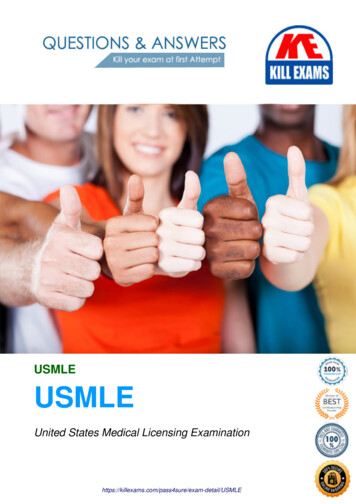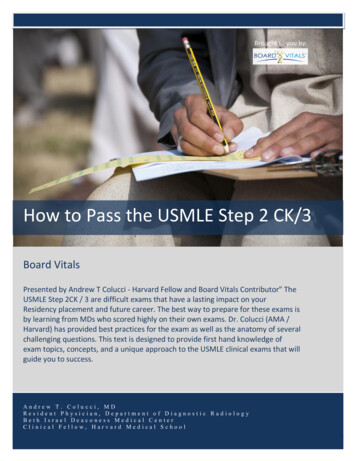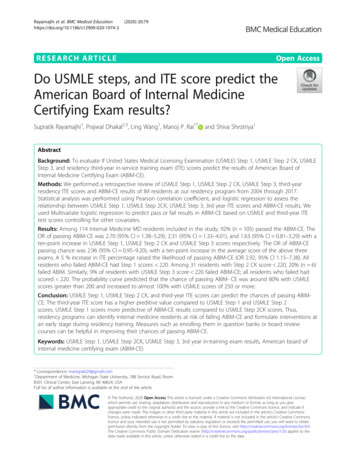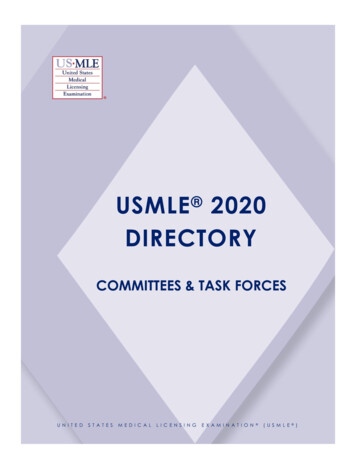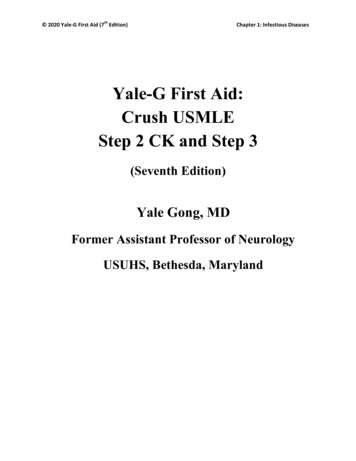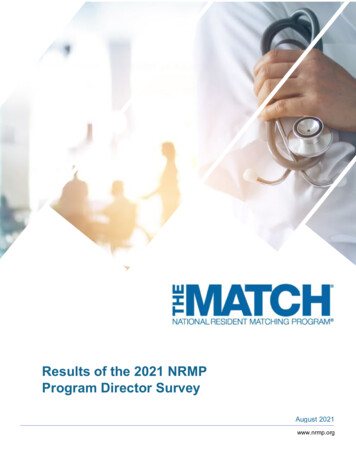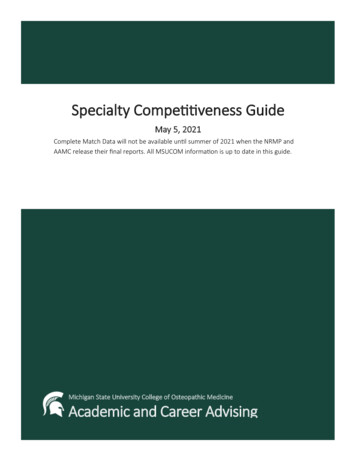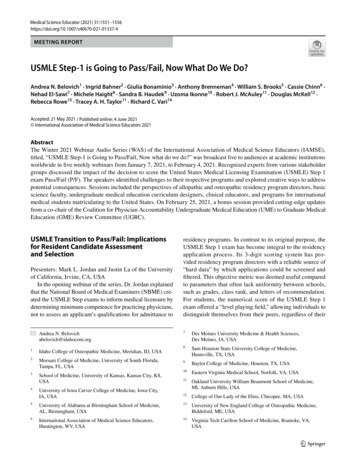
Transcription
Medical Science Educator (2021) 1337-4MEETING REPORTUSMLE Step‑1 is Going to Pass/Fail, Now What Do We Do?Andrea N. Belovich1 · Ingrid Bahner2 · Giulia Bonaminio3 · Anthony Brenneman4 · William S. Brooks5 · Cassie Chinn6 ·Nehad El‑Sawi7 · Michele Haight8 · Sandra B. Haudek9 · Uzoma Ikonne10 · Robert J. McAuley11 · Douglas McKell12 ·Rebecca Rowe13 · Tracey A. H. Taylor11 · Richard C. Vari14Accepted: 21 May 2021 / Published online: 4 June 2021 International Association of Medical Science Educators 2021AbstractThe Winter 2021 Webinar Audio Series (WAS) of the International Association of Medical Science Educators (IAMSE),titled, “USMLE Step-1 is Going to Pass/Fail, Now what do we do?” was broadcast live to audiences at academic institutionsworldwide in five weekly webinars from January 7, 2021, to February 4, 2021. Recognized experts from various stakeholdergroups discussed the impact of the decision to score the United States Medical Licensing Examination (USMLE) Step 1exam Pass/Fail (P/F). The speakers identified challenges to their respective programs and explored creative ways to addresspotential consequences. Sessions included the perspectives of allopathic and osteopathic residency program directors, basicscience faculty, undergraduate medical education curriculum designers, clinical educators, and programs for internationalmedical students matriculating to the United States. On February 25, 2021, a bonus session provided cutting-edge updatesfrom a co-chair of the Coalition for Physician Accountability Undergraduate Medical Education (UME) to Graduate MedicalEducation (GME) Review Committee (UGRC).USMLE Transition to Pass/Fail: Implicationsfor Resident Candidate Assessmentand SelectionPresenters: Mark L. Jordan and Justin La of the Universityof California, Irvine, CA, USAIn the opening webinar of the series, Dr. Jordan explainedthat the National Board of Medical Examiners (NBME) created the USMLE Step exams to inform medical licensure bydetermining minimum competence for practicing physicians,not to assess an applicant’s qualifications for admittance to* Andrea N. Belovichabelovich@idahocom.orgresidency programs. In contrast to its original purpose, theUSMLE Step 1 exam has become integral to the residencyapplication process. Its 3-digit scoring system has provided residency program directors with a reliable source of“hard data” by which applications could be screened andfiltered. This objective metric was deemed useful comparedto parameters that often lack uniformity between schools,such as grades, class rank, and letters of recommendation.For students, the numerical score of the USMLE Step 1exam offered a “level playing field,” allowing individuals todistinguish themselves from their peers, regardless of their7Des Moines University Medicine & Health Sciences,Des Moines, IA, USA8Sam Houston State University College of Medicine,Huntsville, TX, USA1Idaho College of Osteopathic Medicine, Meridian, ID, USA2Morsani College of Medicine, University of South Florida,Tampa, FL, USA9Baylor College of Medicine, Houston, TX, USASchool of Medicine, University of Kansas, Kansas City, KS,USA10Eastern Virginia Medical School, Norfolk, VA, USA11Oakland University William Beaumont School of Medicine,MI, Auburn Hills, USA12College of Our Lady of the Elms, Chicopee, MA, USAUniversity of New England College of Osteopathic Medicine,Biddeford, ME, USAVirginia Tech Carilion School of Medicine, Roanoke, VA,USA34University of Iowa Carver College of Medicine, Iowa City,IA, USA5University of Alabama at Birmingham School of Medicine,AL, Birmingham, USA136International Association of Medical Science Educators,Huntington, WV, USA1413Vol.:(0123456789)
1552school’s ranking or prestige. Despite the advantages of anumerical scoring system, there is a growing consensus thathigh-stake exams no longer best serve holistic evaluation ofresident candidates. Dr. Jordan highlighted the problem of“USMLE mania,” where achieving a high USMLE Step 1score has become the predominant goal of preclinical medical education. This contributes to increased student anxiety,parallel curricula, and increased pressure on medical schoolsto “teach to the test.” Ultimately, the Invitational Conferenceon USMLE Scoring (InCUS) was convened in March 2019,and recommended that the NBME score the USMLE Step 1exam using a P/F paradigm.Dr. La next discussed the USMLE Step 1 P/F transitionfrom the perspective of current residents. He hypothesizedthat input from current residents contributes significantly tothe residency interview process, helping to build successfulteams and environments that facilitate learning and soundpatient care. Current residents can assess the “fitness” ofapplicants for residency as well as their “overall fit” amongstthe cohort by using non-USMLE components of their residency applications [1]. As mixed data exists regarding theability of the USMLE Step 1 to predict resident success, Dr.La presented comprehensive literature reviews demonstrating that other selection criteria are heterogeneously studied,with publications differing even in definition and assessment of resident success [2, 3]. In light of these data, Dr. Laconcluded that there is no single predictive success factorin residency.Dr. Jordan continued the webinar by addressing theimplications of losing the 3-digit USMLE Step 1 score asan objective screening tool for residency candidates. Program directors now face an increased burden in reviewingapplications, raising concerns that applicants could receiveless in-depth reviews. This change leaves applicants withuncertainty about distinguishing themselves for competitivespecialties, particularly if applying from newer, international, or less well-known medical schools. Dr. Jordan thenpresented the advantages and disadvantages of other evaluation metrics, ending with the question of whether residencyprograms will place greater emphasis on the USMLE Step2 Clinical Knowledge (CK) exam. He also noted that manyin-person tools for residency candidate assessment have notbeen feasible due to the SARS-CoV-2 pandemic, such asaway rotations, which were relied upon to observe qualities and factors that electronic applications cannot effectively evaluate. This change introduces greater uncertaintyregarding how candidates are considered for interviews andassessed for residency.In conclusion, Dr. Jordan outlined potential solutions:(1) standardized candidate assessment tools based on specialty or nontraditional assessments (e.g., Jefferson EmpathyScale, Grit Scale); (2) standardized Medical Student Performance Evaluations (MSPEs), rotation evaluations, grades,13Medical Science Educator (2021) 31:1551–1556recommendation letters, and transcripts; (3) increasedmedical school transparency on applicant strengths, professionalism, and performance; (4) program director-drivendevelopment of mission-based holistic criteria for application review; (5) Electronic Residency Application Service(ERAS) modification to permit extraction of informationfor holistic review; and (6) early application cycle to demonstrate program interest.Pass/Fail USMLE Step 1: Implicationsfor a Foundational Sciences DepartmentPresenter: Douglas Gould of the Oakland University William Beaumont School of Medicine, Auburn Hills, MI, USA.In the second installment of this series, Dr. Gould discussedhow P/F scoring of the USMLE Step 1 might broadly impactbiomedical/foundational sciences departments. While USMLEStep 1 scoring will change, its content focus of foundationalsciences will not. Dr. Gould shared the National ResidentMatching Program’s 2018 Program Director survey results,presenting metrics that could replace USMLE Step 1 scoresin screening applications. According to the survey, the topseven criteria used to rank residency applications were (1)USMLE Step 1 score, (2) Letters of Reference, (3) MedicalStudent Performance Evaluation (MSPE), (4) USMLE Step2 CK score, (5) Personal Statement, (6) Grades in requiredclerkships, and (7) Failed USMLE attempts [4]. Dr. Gouldthen shared results from an audience poll question, revealingthat audience members considered USMLE Step 2 CK scores,grades in required clerkships, and letters of reference mostlikely to replace USMLE Step 1 scores to screen residencyapplications. This analysis emphasized the unpredictability ofwhich factors may become most important going forward andunderscored the need for medical schools to be flexible. Dr.Gould stressed the potential for preclinical curricula to transition to P/F as well, possibly reorienting towards USMLE Step2 CK preparation.While Dr. Gould anticipates a de-emphasis on basic science education going forward, holistic review of residencyapplications reveals an opportunity for biomedical and foundational sciences to promote strong applications by providingstudents with more research activities. Dr. Gould showcasedthe Oakland University William Beaumont School of Medicine’s required longitudinal, 4-year research program called“Embark.” In this program, students are paired with mentorsto receive training across multiple research design and implementation domains. Dr. Gould noted that residency programscould use quantifiable student research activities as a metricfor offering residency interviews, which will favor the development of research programs.Dr. Gould concluded with optimism, stating that manyof the changes medical education is currently experiencing have been ongoing, although recent events (such as the
Medical Science Educator (2021) 31:1551–1556SARS-CoV-2 pandemic) have catalyzed and acceleratedthem. He credited the OUWB’s Foundational Medical Studies Department’s collaborative nature, the presence of facultyalready devoted to medical education, and a robust facultydevelopment program with the quick and successful transition to online learning and asynchronous education. Althoughthe number of traditionally structured foundational sciencesdepartments has decreased over the last two decades, overall numbers of basic/foundational science departments haveincreased 33% during the previous 5 years, with 21% of medical school faculty holding a PhD as of 2018 [5]. As continuouschange to medical education is inevitable, Dr. Gould advocatedfor increasing and developing foundational science medicaleducation faculty who are invested in innovating effectiveteaching in the face of unforeseen events, such as COVID-19and the USMLE Step 1 P/F transition.USMLE Step 1 P/F: A UME Curriculum Dean’sPerspectivePresenter: Jonathan Amiel of the Columbia UniversityVagelos College of Physicians and Surgeons, New YorkCity, NY, USA.In this session, Dr. Amiel discussed how the switch toUSMLE Step 1 P/F grading could impact a broad range ofareas in undergraduate medical education (UME). In termsof the mission, objective, values, and ethics of educationalprograms and accreditation, he expressed optimism thatpre-clerkship faculty may take a more holistic approach tothe knowledge and skills students acquire in pre-clerkshipcurricula. Rather than “teaching to the test,” institutionsnow have an opportunity to work with the National Boardof Medical Examiners (NBME) from a competency-basedperspective. While he did not anticipate a significant impacton accreditation in general, Dr. Amiel noted that the NBMEmight increase the USMLE Step 1 passing threshold, introducing higher failure rates that could affect accreditation.Logistically speaking, institutions will still need to ensurethey provide adequate support to learners who have difficultywith standardized tests, including increased support for theUSMLE Step 2 CK exam, which may replace USMLE Step1 as a tool for residency application ranking.Dr. Amiel predicted that the most significant architecturalimpact on UME curricula would be changed dedicated studytime for the USMLE Step exams. If schools are going toincrease USMLE Step 2 CK preparation, dedicated studytime for USMLE Step 1 or elective rotation time could bereduced. This shift could result in individualized study tracksor parallel curricula for different graduating classes, resulting in confusing messaging for students. Concerning thepotential changes in assessment methods, Dr. Amiel anticipated that faculty development programs would provide newtraining for faculty. He emphasized this as an opportunity to1553reframe “assessment of learning” as “assessment for learning” and help faculty broaden their thinking about testingmedical knowledge early in the curriculum. He discussed thepotential impact of the USMLE Step 1 P/F shift on resourcemanagement, as the process of making changes to curriculais resource intensive. Students may also be required to takeUSMLE Step 2 CK earlier to obtain scores needed for residency applications, which would necessitate UME curriculapreparing students earlier. Schools that schedule the USMLEStep 1 exam later in students’ training (e.g., Columbia University) will need to consider shifting both the USMLE Step1 and Step 2 CK exams earlier. Specialties may also begin todevelop and administer their own exams to rank applicants,which would further encourage changes to UME curricula tohelp students be prepared and competitive for their desiredspecialties.Overall, Dr. Amiel suggested that scoring the USMLEStep 1 as P/F will be positive for medical education. However, stakeholders must be careful to mitigate any potentialnegative, unintended consequences. He stressed the importance of basing initiatives in education theory and best practices, promoting competency-based medical education andcooperation with the NBME and USMLE programs. Herecommended that students should be able to demonstratetheir competency in a basic body of knowledge and clinicalreasoning skills before moving to the clinic, yet still haveexperience with high-stake assessments. Finally, Dr. Amielcautioned that any new methods of programmatic assessment should be mindful of holistic review processes and howgenerating data about learner performance may impact residency applications. In particular, institutions must be carefulto employ anti-racist pedagogy and assessment approaches.He concluded with the suggestion that the USMLE Step 1P/F shift may result in an abundance of opportunities forconducting scholarly activity.USMLE Step 1 Going Pass‑Fail: Are We JustKicking the Can Down the Road?Presenters: Bruce Morgenstern of the Roseman UniversityCollege of Medicine, Henderson, NV, USA; Brenda Romanof the Wright State University Boonshoft School of Medicine, Dayton, OH, USA.As the immediate past president and current president ofAlliance for Clinical Affairs, respectively, Drs. Morgensternand Roman discussed endemic issues within the current residency application process that will likely remain after theUSMLE Step 1 scoring changes to P/F. Dr. Morgensternbegan by contrasting the USMLE’s purpose of informinglicensure by assessing physicians’ medical knowledge, values, skills, and attitudes with the off-label use of the examsto rank residency applications. He challenged the ability ofmultiple-choice questions to assess abstract qualities such13
1554as values, skills, and attitudes, noting a similar dilemma formedical education: the ultimate goal of medical educationis to produce “good” physicians, but the field struggles toarticulate how and when an individual is a “good” physician.In response, competency-based medicine is emerging, butmany areas commonly used to measure competence, suchas professional identity development, professionalism, values, and attitudes, are difficult to assess, especially with theintense focus on USMLE Step 1.Dr. Morgenstern acknowledged that although USMLE Step1 scores do not correlate with other measures of overall successin residency, the practice of developing interviewee lists usingUSMLE Step 1 scores is generally accepted. Further contributing to the reliance on ranking tools is the lack of staffing for residency program directors to support holistic application review.Program directors will feel pressured to select applicants likelyto pass specialty boards. They will seek mechanisms to rankapplicants meaningfully since subjective metrics often lackconsistency and undergo “modifier inflation.” The use of modifier inflation leads to a general lack of trust between UME andGME. He proposed that the current residency application process itself may not be fair, stating that ERAS contributes to theoverwhelming number of applicants. The National ResidencyMatch Program algorithm is proprietary, so it is impossibleto verify whether/how it favors applicants or programs. Goingforward, how can program directors screen applicants and conduct holistic reviews? Dr. Morgenstern emphasized that it isincumbent upon UME to develop tools that are more intentionalin their design and purpose to assess “good” residents compared to the minimum competency licensure exams previouslycoopted for the match process.Dr. Roman then continued the webinar by further exploring problems that will remain inherent to the residency matchprocess despite the USMLE Step 1 P/F transition, such as theissue of student stress. Student stress will probably shift fromUSMLE Step 1 to USMLE Step 2 CK if program directorsfocus more on USMLE Step 2 CK as an application screening tool. Clerkship years may be negatively affected, detracting from patient care and clinical learning. Medical schoolsand programs will still be evaluated by match rate, with thejob performance of Student Affairs Deans tied to successfulmatch rates. Program directors may still negatively evaluateapplicants with well-explained gaps in their education if theyrequired more time to complete medical school, and studentsand programs will still try to “game the system” to their advantage. Despite these issues, Dr. Roman shared that almost allstudents successfully match in a residency program.As the webinar drew to a close, Dr. Roman reminded theaudience that medical schools could improve the residencyapplication process and trust between UME and GME bydeveloping better ways to identify and address professionalism issues. This may include involving basic science faculty early on in medical curricula to help detect concerning13Medical Science Educator (2021) 31:1551–1556patterns of unprofessional behavior. She left the audiencewith a provocative proposal intended to spark thought anddiscussion. With a disclaimer that she did not intend theaudience to consider the idea in its current form seriously,Dr. Roman suggested that programs should define an optimal fit for residents in their programs and applicants shoulddefine their preferred residency characteristics. The matching algorithm then should prioritize compatibility betweenapplicant and program. Dr. Roman also suggested that asa field, medicine should ask media publications to stopranking schools and hospitals, as this creates false realities that may drive students to apply to too many residencies. Ultimately, UME and GME must work together moreclosely to avoid simply moving the stress from USMLE Step1 to USMLE Step 2 CK, and to involve both clinical andbasic science faculty in helping program directors assessapplicants.USMLE Step 1: Osteopathicand International PerspectivesPresenters: John (Jack) Boulet of the Educational Commission for Foreign Medical Graduates (ECFMG) (retired), Philadelphia, PA, USA; Robert Cain of the American Associationof Colleges of Osteopathic Medicine (AACOM), WashingtonD.C., USA.Dr. Boulet began the webinar by presenting the likelyimpact of the recent changes to the USMLE Step Seriesexams on international medical graduates (IMGs) applying to United States (U.S.) residency programs. For IMGs,the USMLE Step exams carry additional weight beyondtheir use in the residency application screening process asthey are also necessary for Educational Commission forForeign Medical Graduates (ECFMG) Certification. TheAccreditation Councils for Graduate Medical Education(ACGME) will not allow their programs to admit IMGswithout ECFMG certification. Previously, ECFMG Certification required applicants to successfully complete theUSMLE Step 1 exam, USMLE Step 2 CK exam, and thenow-suspended USMLE Step 2 Clinical Skills (CS) exam.The ECFMG now allows applicants to demonstrate clinicalskills through alternative avenues, including having a licenseto practice medicine in another country or passing a standardized clinical skills exam for medical licensure. Additionally, students may meet this requirement by graduatingfrom a medical school that meets specific accreditation,loan-program, or partnership requirements. Finally, IMGsmust also pass the Occupational English Test in medicineto assess the communication requirements formerly testedby USMLE Step 2 CS.Dr. Boulet next shared that, on average, IMGs’ matchrate with U.S. residencies is approximately 60% (comparedto 90% for medical graduates trained in the U.S.), and
Medical Science Educator (2021) 31:1551–1556thus, they tend to submit a larger number of applications.This increases competition for interviews. As IMGs can nolonger depend upon strong numerical USMLE Step 1 scoresto distinguish themselves, they must now reconsider how tostand out from their peers. Dr. Boulet suggested that usingthe USMLE Step 2 CK exam to screen residency applications may disadvantage certain IMGs, as their schools maynot offer early clinical experiences or be able to add them.Schools with a small minority of graduates applying toU.S. residencies may not restructure their curriculum, andU.S. residency program directors may rely on the international reputation of medical schools. Given these concerns,IMGs’ motivation to secure U.S. residency programs coulddecrease. Dr. Boulet concluded by emphasizing the needto reevaluate the residency selection process, supportingefforts by the Coalition for Physician Accountability, theECFMG, and the National Board of Osteopathic MedicalExaminers (NBOME) to make the UME to GME transitionmore efficient.Dr. Cain continued the webinar by sharing the overallimpact of USMLE Step 1 P/F scoring on osteopathic medicine. Despite the osteopathic community having its ownindependent licensing body, the NBOME, many residencyprograms require doctor of osteopathic medicine (DO)students to take the USMLE Step 1 to be considered forresidency interviews and/or admission. This requirementis associated with high financial, personal, relational, andopportunity costs to students, and osteopathic medicalschools feel the impact of the “USMLE Step 1 mania” ontheir preclinical curricula. These additional costs raise ethical questions regarding the fairness of requiring studentsto take two licensure exams, particularly considering theUSMLE Step 1 transition to P/F scoring. When the NBMEscored USMLE Step 1 numerically, DO students experienced the benefit of distinguishing themselves amongst otherDO, MD, and IMG applicants. However, this benefit disappears with P/F scoring, particularly since the ComprehensiveOsteopathic Medical Licensing Examination (COMLEX)Level 1 and the USMLE Step 1 test the same material andthe COMLEX also fulfills medical licensure requirements.Next, Dr. Cain presented the advantages and disadvantages of USMLE Step 1 P/F scoring for osteopathic medicalstudents. Decreased stress and cost for students are advantageous, along with schools experiencing less pressure to“teach to the test.” Reduced pressure to score highly on anassessment designed for allopathic medical education alignswith and supports the development of the osteopathic professional identity. Disadvantages include concerns regardingreduced transparency of the residency application screening process and whether program directors will rely onschool reputation or their familiarity with the individualDO UME programs. Finally, a greater portion of DO students than MD students pursue clinical clerkship training1555in non-hospital-based settings (i.e., ambulatory and physical rehabilitation training), which disadvantages them fromscoring as highly on the USMLE Step 2 CK exam. For DOstudents, this raises the concern that the USMLE exams havebeen misused as tools for residency placement, particularlysince there are differences in performance compared to allopathic students.In contrast, the COMLEX exams are designed to testthe osteopathic-specific components at each stage of student development and are embedded throughout the 4-yearUME experience. To summarize the osteopathic community’s general sentiment, Dr. Cain stated that the change ofthe USMLE Step 1 scoring to P/F could harm DO studentswhen there should be no impact. This outcome highlightsa great need for continuing education around the use of theCOMLEX exam and understanding different tools for determining residency readiness.Coalition for Physician AccountabilityUME‑GME Review CommitteePresenter: Elise Lovell of the University of Illinois at Chicago, Chicago, IL, USA.During the sixth and final webinar of this series, Dr. Lovell,Co-Chair of the Coalition for Physician Accountability UMEGME Review Committee (UGRC), provided a front-lineupdate of the UGRC’s work to review the UME to GME transition. Dr. Lovell first introduced the Coalition for PhysicianAccountability as a collaboration between national organizations responsible for the education, assessment, accreditation, certification, and licensure processes ranging from UMEto practicing physicians. Member organizations include theAssociation of American Medical Colleges (AAMC), theAmerican Association of Colleges of Osteopathic Medicine (AACOM), the American Board of Medical Specialties(ABMS), the Accreditation Council for Continuing MedicalEducation (ACCME), the Accreditation Council for Graduate Medical Education (ACGME), the American MedicalAssociation (AMA), the American Osteopathic Association(AOA), the Council of Medical Specialty Societies (CMSS),the Educational Commission for Foreign Medical Graduates(ECFMG), the Federation of State Medical Boards (FSMB),the Liaison Committee of Medical Education (LCME), theNational Board of Medical Examiners (NBME), and theNational Board of Osteopathic Medical Examiners (NBOME)as well as members of the public. The mission of the coalitionis “to advance health care and promote professional accountability by improving the quality, efficiency, and continuity ofthe education, training, and assessment of physicians” [6].To provide the audience with context for the developmentof the coalition’s UGRC, Dr. Lovell revisited the recommendations resulting from the Invitational Conference on13
1556USMLE Scoring (InCUS) in March 2019: (1) consider scorereporting changes, e.g., pass/fail, composite score, and categorical/tiered scoring for USMLE exams; (2) research howUSMLE is (or is not) related to performance in residencyand practice; (3) continue work to address group (racial/demographic) differences in USMLE exam scores; and (4)undertake a comprehensive review of the UME to GMEtransition process. While the first recommendation regarding the USMLE Step 1 P/F scoring has received significantattention, the USMLE Step 1 numerical score was only onefactor of many contributing to the broader problems surrounding the UME to GME transition. After briefly discussing progress made towards meeting the first three recommendations, Dr. Lovell focused on reviewing the currentUME-GME transition system.The UME to GME review process was anticipated toinvolve eight significant areas of focus: (1) improving theapplication process, (2) reducing the number of applicationssubmitted by applicants, (3) improving transparency of theUME to GME transition process, (4) identifying potentialadjustments to the Match, (5) improving program directors’ability to more holistically review applicants, (6) improvingthe trust/transparency of medical school-based assessments,(7) reviewing the role of standardized testing in UME toGME transition, and (8) developing assessments for otheressential measures beyond knowledge. InCUS identified theCoalition for Physician Accountability as the organizationbest suited to address this review. In September of 2019, thecoalition formed a planning committee to identify the UGRCmembership and determine its key questions, deliverables,milestones, timeline, and budget.Membership of the UGRC comprises representativesfrom each of the coalition member organizations, medicalstudents, resident physicians, members of the public, andsupport staff. Along with Dr. Lovell, Dr. George Mejicanowas selected to co-chair the UGRC. Areas of focus for theUGRC include fit of applicants for residency programsbased on abilities and interests, an increase of trust betweenmedical schools and residency programs, and mitigation ofreliance on licensing exams during the application process.Also, the UGRC’s focus encompasses ensuring fairness forall types of applicants (allopathic, osteopathic, and international medical graduates) while considering cost and thepotential for systemic bias and diversity issues throughout the transition from UME to GME. The coalition has13Medical Science Educator (2021) 31:1551–1556requested that the UGRC also review and consider specialtyspecific competencies, including when and how specialtyspecific preparatory training for residency should occur andwhere responsibility should rest in resolving any gaps inresidency readiness.Once established, the UGRC created workgroups toaddress the charges from the coalition planning committeeand added overall considerations of diversity, equity, inclusion, fairness, student wellbeing, and the public good. TheUGRC asked the workgroups to plan for continual modification and support the formation of an iterative review processof the UME-GME transition going forward. Dr. Lovell concluded by inviting the audience to follow UGRC meetingupdates on http:// physi ciana ccoun tabil ity. org/, providing anexpected timeline for delivering the URGC’s recommendations. These draft recommendations will be re
USMLE Step 2 CK exam, which may replace USMLE Step 1 as a tool for residency application ranking. Dr. Amiel predicted that the most signicant architectural impact on UME curricula would be changed dedicated study time for the USMLE Step exams. If schools are going to increase USMLE Step 2 CK preparation, dedicated study time for USMLE Step 1 or elective rotation time could be reduced. This .


